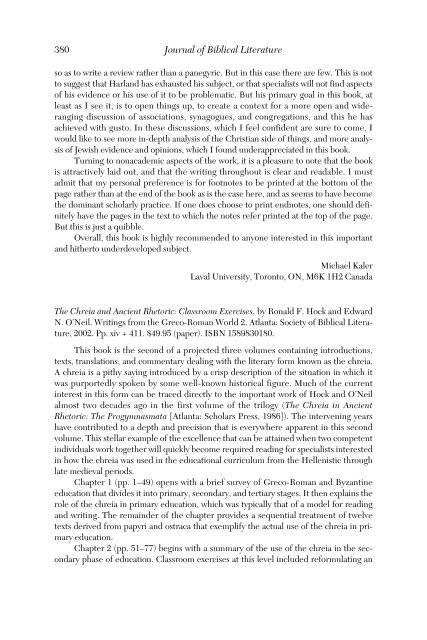Journal of Biblical Literature - Society of Biblical Literature
Journal of Biblical Literature - Society of Biblical Literature
Journal of Biblical Literature - Society of Biblical Literature
Create successful ePaper yourself
Turn your PDF publications into a flip-book with our unique Google optimized e-Paper software.
380 <strong>Journal</strong> <strong>of</strong> <strong>Biblical</strong> <strong>Literature</strong><br />
so as to write a review rather than a panegyric. But in this case there are few. This is not<br />
to suggest that Harland has exhausted his subject, or that specialists will not find aspects<br />
<strong>of</strong> his evidence or his use <strong>of</strong> it to be problematic. But his primary goal in this book, at<br />
least as I see it, is to open things up, to create a context for a more open and wideranging<br />
discussion <strong>of</strong> associations, synagogues, and congregations, and this he has<br />
achieved with gusto. In these discussions, which I feel confident are sure to come, I<br />
would like to see more in-depth analysis <strong>of</strong> the Christian side <strong>of</strong> things, and more analysis<br />
<strong>of</strong> Jewish evidence and opinions, which I found underappreciated in this book.<br />
Turning to nonacademic aspects <strong>of</strong> the work, it is a pleasure to note that the book<br />
is attractively laid out, and that the writing throughout is clear and readable. I must<br />
admit that my personal preference is for footnotes to be printed at the bottom <strong>of</strong> the<br />
page rather than at the end <strong>of</strong> the book as is the case here, and as seems to have become<br />
the dominant scholarly practice. If one does choose to print endnotes, one should definitely<br />
have the pages in the text to which the notes refer printed at the top <strong>of</strong> the page.<br />
But this is just a quibble.<br />
Overall, this book is highly recommended to anyone interested in this important<br />
and hitherto underdeveloped subject.<br />
Michael Kaler<br />
Laval University, Toronto, ON, M6K 1H2 Canada<br />
The Chreia and Ancient Rhetoric: Classroom Exercises, by Ronald F. Hock and Edward<br />
N. O’Neil. Writings from the Greco-Roman World 2. Atlanta: <strong>Society</strong> <strong>of</strong> <strong>Biblical</strong> <strong>Literature</strong>,<br />
2002. Pp. xiv + 411. $49.95 (paper). ISBN 1589830180.<br />
This book is the second <strong>of</strong> a projected three volumes containing introductions,<br />
texts, translations, and commentary dealing with the literary form known as the chreia.<br />
A chreia is a pithy saying introduced by a crisp description <strong>of</strong> the situation in which it<br />
was purportedly spoken by some well-known historical figure. Much <strong>of</strong> the current<br />
interest in this form can be traced directly to the important work <strong>of</strong> Hock and O’Neil<br />
almost two decades ago in the first volume <strong>of</strong> the trilogy (The Chreia in Ancient<br />
Rhetoric: The Progymnasmata [Atlanta: Scholars Press, 1986]). The intervening years<br />
have contributed to a depth and precision that is everywhere apparent in this second<br />
volume. This stellar example <strong>of</strong> the excellence that can be attained when two competent<br />
individuals work together will quickly become required reading for specialists interested<br />
in how the chreia was used in the educational curriculum from the Hellenistic through<br />
late medieval periods.<br />
Chapter 1 (pp. 1–49) opens with a brief survey <strong>of</strong> Greco-Roman and Byzantine<br />
education that divides it into primary, secondary, and tertiary stages. It then explains the<br />
role <strong>of</strong> the chreia in primary education, which was typically that <strong>of</strong> a model for reading<br />
and writing. The remainder <strong>of</strong> the chapter provides a sequential treatment <strong>of</strong> twelve<br />
texts derived from papyri and ostraca that exemplify the actual use <strong>of</strong> the chreia in primary<br />
education.<br />
Chapter 2 (pp. 51–77) begins with a summary <strong>of</strong> the use <strong>of</strong> the chreia in the secondary<br />
phase <strong>of</strong> education. Classroom exercises at this level included reformulating an

















